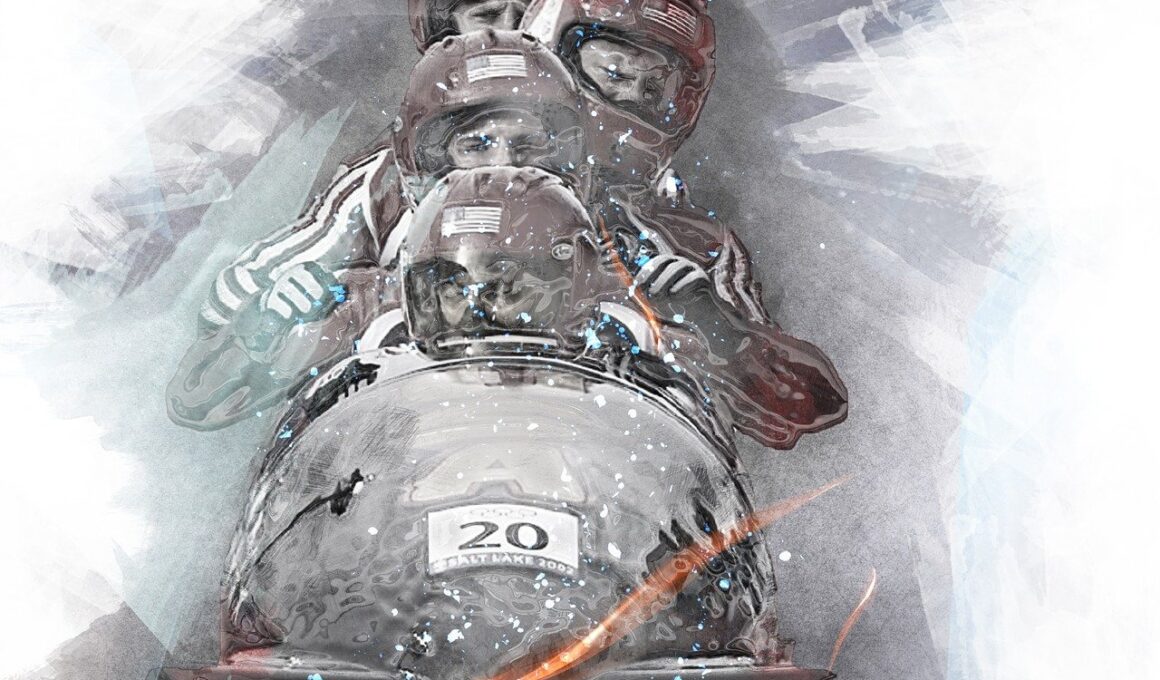A Day in the Life of a Professional Bobsled and Luge Athlete
Waking up early in the morning, a professional bobsled and luge athlete’s day starts with a structured routine. They begin by fueling their bodies with a nutritious breakfast, consisting of whole grains, fruits, and protein sources. Proper nutrition is vital for optimizing performance as these athletes prepare for intense training sessions. After breakfast, they focus on mental preparation, reviewing their goals for the day. Visualization techniques are key; they imagine the course, their runs, and optimal positioning. This mental groundwork is crucial for any successful athlete. Following their mental warm-up, they may head to a gym or training facility, where strength and conditioning sessions take place. Athletes work on enhancing their core strength, leg power, and speed, which are critical in bobsledding and luge. Specific exercises include squats, deadlifts, and sprint drills. After a grueling workout, they usually hydrate and refuel with post-training snacks, ensuring recovery begins immediately. Finally, they might revisit the track for a practical session to implement skills honed in the gym during the early hours, enhancing their proficiency and technique on the ice.
After a physically demanding morning, the afternoon is reserved for recovery and skill development. Rest is equally as important as training; thus, dedicated time is spent on stretching, foam rolling, and other recovery practices. Athletes commonly incorporate techniques like massage therapy and physiotherapy to maintain their bodies’ resilience and prevent injuries. Nutrition plays a significant role in recovery; athletes consume high-quality post-training meals rich in carbohydrates and protein. They also stay well-hydrated throughout the day to support muscle recovery. Later in the day, athletes might engage in strategy sessions with their coaches, discussing course dynamics, equipment adjustments, and tactics for upcoming competitions. Taping sessions often follow, where athletes prepare their sleds and equipment meticulously. Proper sled maintenance is critical. They ensure their equipment is optimally tuned and free from any damage, which could affect performance on race day. In these discussions and preparations, they emphasize teamwork and communication, refining their understanding of each curve and straightaway on the track. This constant improvement mindset is crucial for an athlete looking to succeed in competitive bobsledding and luge.
Evening Routine and Reflection
The evening typically involves a winding-down period, where athletes reflect on their day. Journaling can provide insights into their training experiences, logging achievements, and areas for further improvement. They review their performance against set goals, noting progress over time and how specific strategies impacted their results. Sharing successes and challenges with teammates facilitates a supportive training environment and strengthens bonds. Enjoying a well-balanced dinner is essential during this recovery phase; meals rich in ingredients yielding healthy fats, proteins, and complex carbohydrates are preferred. This helps promote muscle recovery and replenish energy supplies after a rigorous day. Post-dinner, athletes are encouraged to engage in activities unrelated to their sport to enhance psychological well-being. Some might enjoy reading or engaging in casual hobbies, while others relax with family and friends. Quality sleep is crucial is another key component of recovery; ensuring they get adequate rest strengthens their potential for improved performance. Strong phosphorylation of muscles occurs during sleep, which is an essential recovery process. Evenings culminate in careful planning for the next day, laying out workout gear and setting fresh goals to drive future training sessions.
On weekends, training often shifts gears, as athletes engage in time trials and competitions. This is their chance to showcase the skills honed during practice throughout the week. The adrenaline rush experienced during competitions is unlike any other, driving the athletes to perform at their peak under pressure. Additionally, being watched by sports fans and other competitors adds an electric ambiance, pushing them to strive for excellence. Before competitions, rigorous warm-up routines ensure that their muscles are primed and ready to excel. These routines include dynamic stretching and sprints, which prepare their physical condition to compete at high levels. Psychologically, they utilize visualization once more, imagining their runs and feeling every twist and curve of the track. As the competition day arrives, athletes have predetermined strategies in place based on previous experiences. The importance of consistency cannot be overstated, coupled with the understanding of weather conditions and track dynamics. The thrill of racing down the course is exhilarating, but a professional must focus solely on execution, trusting their training and the work put forth in preparation. Experiencing exhilarating moments like these reinforces commitment to the sport.
Community and Support Network
Moreover, the role of the community and support networks in an athlete’s journey cannot be understated. Coaches, fellow athletes, and family members provide constant encouragement, instilling confidence crucial to performance enhancement. Social events and gatherings strengthen relationships within the sport, offering additional collaboration channels. National and regional federations also play pivotal roles in facilitating athletes’ development by providing resources, sponsorships, and opportunities to compete at higher levels. Engagement in community support leads to a deeper appreciation for the sport and commitments beyond personal ambitions. Mentorship from past athletes often guides newcomers, sharing invaluable insights from experiences that shaped their careers. This camaraderie fosters connections spanning across training facilities and competitions, offering sharing of techniques and competitive strategies. As athletes engage with younger individuals pursuing their passions, they create role models, further propagating the legacy of the sport. Celebrating milestones, both individually and collectively, and acknowledging the contributions of every team member leads to sustained motivation and dedication to their craft. The athletes remain resilient, knowing success is often a shared journey, fostering excellence in bobsledding and luge.
As seasons change, new objectives emerge, influencing training approaches and competition structure. Athletes adapt to various weather conditions, preparing for unique challenges faced during the winter sports season. Practicing in diverse climates, from chilling icy mornings to changing weather patterns makes them adaptable. Ice conditions may vary due to changes in temperature, which requires flexibility in skill sets. They train in dry-land settings, simulating different environments, ensuring preparedness for every scenario. Engaging in additional activities like skiing and track cycling further diversifies their skill set, enhancing performance across different events. Each season presents opportunities to take advantage of learning new techniques while reviewing previous performances. Athletes return to foundational training practices, refining their principles, and implementing adjustments based on analytical reviews and feedback. They are always open to learning and evolving, drawing upon their experiences to foster an environment of continual growth. Not only does this mentality apply to individual athletes, but it also translates into team dynamics as they push each other towards collective achievements, ensuring sustained progress toward competitive ambitions in bobsled and luge.
The Future of the Sport
Looking ahead, the future of bobsledding and luge is vibrant due to growing interest and investment in winter sports. With the globalization of sports, various countries invest resources in athlete development, equipment innovation, and infrastructure advancement. Increased exposure through media allows more audiences to participate in the excitement surrounding these sports. Additionally, advancements in technology have revolutionized sled designs, optimizing performance and safety standards. Such developments inspire a new generation of athletes eager to experience the adrenaline boosts of these fast-paced sports. The establishment of new programs to introduce youth engagement provides opportunities for future stars. Initiating initiatives designed to make the sport more inclusive ensures diverse representation, expanding its reach. With programs in schools and community associations, aspiring athletes can access training facilities and mentorship. As the sport grows in visibility, maintaining its core principles—inclusivity, tradition, and excellence—will ultimately shape the opportunities for future generations. Athletes remain committed to pursuing medal dreams, knowing their devastating approaches contribute to inspiring passion for future bobsledding and luge competitors worldwide.
Overall, a day in the life of a professional bobsled and luge athlete is filled with rigorous training, community involvement, and personal growth. From early morning workouts to detailed evening reflections, every aspect contributes to their success. As the athletes navigate the thrilling challenges posed by their sport, they embody resilience, adaptability, and a commitment to excellence. Their interactions within supportive communities reinforce their passion and dedication while also inspiring others. The dedication required in training reflects in competitions, where they show the power of teamwork and individual prowess. Every moment spent honing skills and reviewing techniques plays a role in performance surges. Athletes commit to constant learning and improvement, embracing every opportunity to better their skills. Their achievements amidst challenges provide a sense of fulfillment, making every ounce of effort worthwhile. Looking into the future, they aspire to elevate the sport and increase interest, reaching broader audiences. By investing in young talent and fostering inclusiveness, their legacy continues. Through hard work, determination, and dedication, these athletes represent the pinnacle of winter sports, with bobsled and luge remaining an incredible aspect of the winter sports culture.


